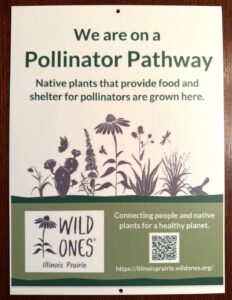Pollinator Pathway Project
The Illinois Prairie Chapter of Wild Ones Pollinator Pathway Project documents locations of native plants, shrubs or trees in Central Illinois (Champaign, DeWitt, Livingston, McLean, Peoria, Tazewell, and Woodford counties) by those participants who commit to:
- planting native plants in their yards or even in a pot
- avoiding the use of insecticides on and near native plants
- limiting the use of herbicides on and near native plants
The commitment by participants to plant natives without use of insecticides and herbicides on them will contribute to the health and abundance of pollinators and the native plants that sustain them.
Why Creating Pollinator Pathways Is Important
In Illinois since the early 1820’s, the abundance of native plants has been replaced by modern agriculture except for in nature preserves and parks. Also, the promotion of chemical control of insects and “weeds” in yards and fields has resulted in a steep decline in pollinators.
Just planting one native plant, shrub or tree in your yard without chemical pest control, helps to provide food essential for pollinators. The project builds awareness of local native plantings and participants fill in gaps where resources for pollinators are scarce.
How Do I Participate in the Pollinator Pathway Project?
- Decide to plant at least one native plant, shrub or tree in your yard or in a pot. The most effective pollinator pathway does have blooming natives in spring, summer and fall.
- Commit to avoiding and limiting the use of insecticides and herbicides in your yard around your native plants.
- Complete the Application Form. The Application Form includes:
- Location information
- Number of natives
- Size of your native planting
- Types of plants
- Option to request a Pollinator Pathway Sign for your yard.
- Upon submission of the application, the Pollinator Pathway committee will review your application and then include a ‘pin’ to your approximate location on the Pollinator Pathway Map . The map does not include any names and addresses, only a ‘pin’ of the location.
- If you requested a sign, the committee will arrange delivery.
Viewing the Pollinator Pathway Map
The Pollinator Pathway Map is a series of “pins” each identifying a specific location in the map area. You can zoom into a particular area by clicking on an individual “pin” to see the current size of the individual planting and the seasons plants bloom in that location.
Signage for Pollinator Pathway Participants
Our signs have recently been updated to align with Wild Ones new design standards. The signs are currently available for no charge to new Pathway participants who are Wild Ones members. If you would like to become a member Join Wild Ones Now. Pollinator Pathway participants who do not belong to Wild Ones may purchase a sign for $10. Members who previously joined the Pathway and would like a new replacement sign may purchase a new sign for $5. Signs can be mailed for the cost of postage, or a member of the Pollinator Pathway committee can arrange delivery.
The signs are 8.75´ wide and 11.75´ tall and are printed on weather resistant 1/8´ thick plastic board and have pre-drilled holes at the top and bottom to facilitate mounting to a pole or fence.
Where Can I Get Native Plants
Each year, Illinois Prairie Wild Ones has a native plant sale, Plant Sale – Wild Ones Illinois Prairie Chapter.
Many local garden shops are now providing native plants. We have some listed on our webpage.
Resources For Planting Native Plants
Please visit the Learn section of our website. Both the Handouts and Guides section and the Plant Information section contain a variety of useful resources about native plants.
University of Illinois Extension site Your Hub for Illinois Pollinators | Illinois Pollinators
The Natural Resources Conservation Service has an excellent section regarding pollinators, the plants they need, and garden designs on their website. You can access it at https://www.nrcs.usda.gov/conservation-basics/conservation-by-state/illinois/ecological-sciences-illinois
If you have questions about this program, please contact the Pollinator Pathway Committee using the Chapter’s email address [email protected].

